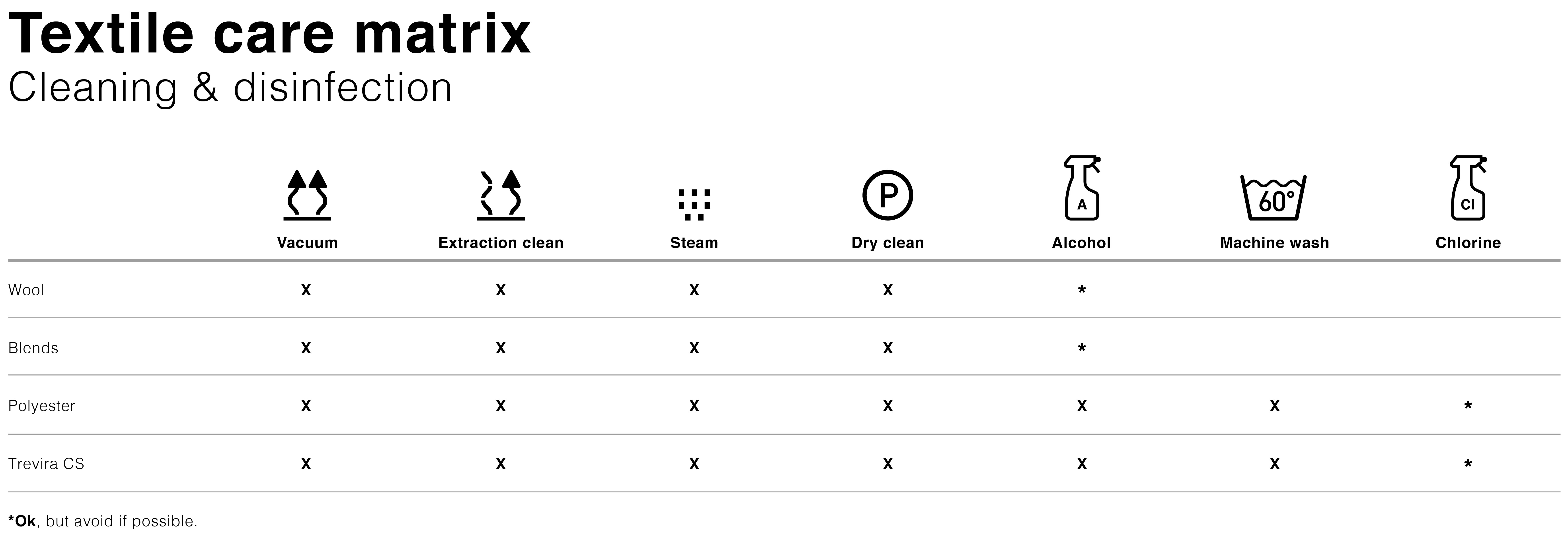First of all, hygiene is crucial to keep the coronavirus from spreading. In times like these we should all keep distance to other people, wash our hands and make sure our workspaces are clean. Above all you should comply to the latest guidelines from your local authority.
Using the textiles
According to research, the risk of contracting the coronavirus from textiles is low. The World Health Organization states that touching a contaminated surface is not the primary way of spreading or contracting the virus. You cannot be infected by just touching something because the virus needs to reach mucous membranes in your mouth, nose or eyes.1 That’s why washing your hands and not touching your face in public spaces are keys to avoid an infection. This is also what adds fuel to the debate about face masks. As long as they remain clean, they can probably protect yourself and others effectively. But if you start adjusting your mask with dirty hands or use the same one many times the outcome might be the opposite.
Just like any other virus this one needs a host body to stay alive and reproduce. Once the virus is out in open air it’s weakened pretty quickly.2 Studies show that the maximum life span of the virus is 48 hours on porous surfaces like textiles.3 Furthermore, the tiny holes that make these surfaces porous can trap the virus and prevent it from being transferred to people.4 This means that in case of suspected contamination you can leave the textile unused for 48 hours as a simple action to stay safe.

Cleaning and disinfecting the textiles
The coronavirus is enveloped by a protective fat layer that it needs to stay alive. This layer can easily be destroyed using regular soap or detergents.5 That’s why washing your hands and washing your textiles are effective ways to kill the virus. Before disinfecting any textile, you should clean it properly. In case of contamination we recommend the following actions depending on what material you are dealing with.
Wool (and wool blends)
Do:
Dry clean the textile. This is the standard way of cleaning wool products. Keeping wool dry is key to maintaining its natural antimicrobial qualities.
If necessary:
Disinfect the textile. Using ethanol will strip the wool of lanolin. It will not really damage the fabric, but it may cause minor colour changes and slightly reduce its lifespan. Avoid this if possible, and if you do use a disinfecting formula on your woollen textile, try on a hidden surface first.
Don’t:
Do not wash woollen textiles and do not clean them using chlorine-based detergents.


Polyester and Trevira CS
Do:
Wash the textile. Our curtains can be dry cleaned or washed at 60°C, with gentle spinning. Wash them separately and be careful not to overload the washing machine. Hang dry and iron on medium heat or steam before hanging them.
If necessary:
Disinfect the textile. Using ethanol on polyester or Trevira CS is not a problem. It will not damage the fabric or change its colour.
Clean the textile with chlorine-based detergents. These formulas may not damage the fabric, but we recommend that you stick with the other cleaning methods.

The bottom line
If you suspect a textile to be contaminated with the coronavirus you should simply leave it or clean it. When you leave the textile unused for 48 hours the virus will automatically die because it lacks a host body. When you clean the textile using regular detergents the protective fat layer of the virus will be destroyed which makes it vulnerable and ultimately kills it. Of course you can use both of these methods to stay on the really safe side.
Read more care instructions here and contact your sales representative for further support.
Take care,
Svensson Crew
References
1https://www.who.int/news-room/q-a-detail/q-a-how-is-covid-19-transmitted
5https://www.sciencemag.org/news/2020/03/does-disinfecting-surfaces-really-prevent-spread-coronavirus


